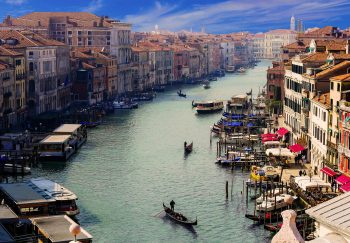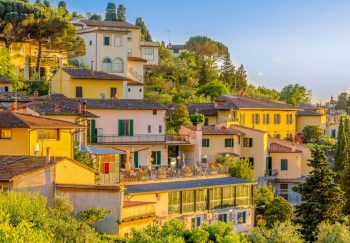When I was first thinking about this month’s Italy Roundtable theme MYTHS and LEGENDS I immediately thought of the Montesiepi Chapel Tuscany where an actual sword is embedded in real stone.
It is believed that it was placed there by Saint Galgano during the 12th century when he wanted to mark a location for a vision with an cross. He had no cross with him so he put his sword in the ground. The sword remained there forever. You can still see the handle of the sword in the Montesiepi Chapel.
Whatever your thoughts might be about visions or the story, studies have been done on the sword’s metal that suggest it could have come from the 12th Century. This means that this sword could be in a real stone and was the inspiration for Excalibur’s Arthurian legend.
It’s impossible to say for certain if that’s true or how the Montesiepi Chapel blade got into the stone. While I enjoy sharing this story with you all, I decided to concentrate on some myths that sound cool, but which we can learn facts about.
Although it may seem boring, I am a firstborn. It’s part of my nature.
It’s been said that things sound better in Italian. For example, I stopped calling it “fruit-salad” now. It sounds so much more interesting when I tell my family that we are having “macedonia”, for dessert.
Many Italophiles, including yours truly, attach romantic value to the sounds of Italian words for everyday things. This can also be applied to the stories that we hear as we travel around the country. It can be entertaining to believe stories that sound good, even if there is evidence to the contrary.
Some myths about Italy have been perpetuated by well-meaning travel writers and tour guides. Perhaps they didn’t do enough research or they simply like the myth. Truths are good, even if it means losing something more romantic. Here are four myths about Italy and the truths that they conceal .
Bernini’s Fountain at Borromini Church is Aghast
The Piazza Navona, an oblong square, is a popular stop on any . It is fun to imagine the stadium once being in the area, leaving its mark on the shape of this piazza many centuries later. It is amazing to see the Bernini sculptures at the central fountain. The beautiful Borromini façade of the Church of Sant’Agnese, Agone makes for a great backdrop for photos.
Some guides and writers believe that this story is based on a truth: Francesco Borromini and Gian Lorenzo Bernini were rivals and contemporaries. It would be an understatement to say that the men did not get along. One legend says that Bernini’s Fountain of the Four Rivers, the center of Piazza Navona’s Piazza Navona, has one statue that seems to recoil from the façade of the Borromini-designed church, as though it is horrified by the work.
It’s a great story. It’s a 17th-century shade, and it would have been difficult to throw due to the amount of carving involved. This is dedication, y’all.
It’s false. Borromini’s facade was built between 1653-1657. Bernini’s fountain was created in 1651, before Borromini was even offered the job at the Church of Sant’Agnese. It is not a look Bernini is displaying of disgust – it’s simply the Rio de la Plata figure, one of four rivers, carved so beautifully that it looks like he’s actually moving.
Mussolini made the trains run on time
This is actually one my favorite myths because it’s still said in Italy from time to time – but not by tour guides or travel writers. It’s the Italians who say it.
This dig is intended to suggest that, despite all his faults and failures, the Italian dictator managed to get the trains running on time. Which (the insinuation continued) the government has failed since then. This is becoming less and less common, since it was mostly older generations that said it.
It is true that the rail system of Italy improved during the 1920s. However, this was mainly due to work done long before Mussolini became president. Importantly, even though the Fascists ruled, the Italian rail system wasn’t punctual.
While trains are not perfect, they are still the best way to travel around the country. Yes, I love Italian trains so much that I wrote an entire book about them .
Mussolini, it is so.
Italian Wedding Soup is served at weddings
The amount of food served at Italian weddings is legendary. There are many jokes about fasting the week before a wedding to make sure you don’t explode. There are a lot of different types of food. It’s not a tasting menu.
However, you won’t find any “Italian Wedding Soup” on any reception menu. The canned version of this soup can be found in many American grocery stores. What’s the answer?
This soup, which is a mixture of meat and dark leafy greens in clear broth, has nothing whatsoever to do with weddings or marriage. The original Italian phrase that described the soup was “minestra martata” or “married soup.” Italians believe foods that combine well are “married well,” so the name “minestra Maritata” was just a way to say the meat and vegetables in the soup tasted good together.
It’s easy to put the word “Italian” on almost anything to make it more appealing. So it’s not surprising that Campbell’s or whoever brought this mistranslation into America chose “Italian Wedding Soup.” This soup is absolutely nothing to do with nuptials.
The Bridge of (Prisoner’s) Sighs
Venice seems almost impossible to love. (No, it’s not the myth. But I will admit that it’s opinion. It is not surprising that one of the most iconic monuments in the country has a romantic legend associated with it, even though it is mostly depressing.
The Bridge of Sighs, a 17th-century bridge connecting the Palazzo Ducale and the prison next to it, crosses high above the Rio di Palazzo canal. According to the legend, the name comes from the sighs that prisoners used to emit when entering the prisons. They could see the city beyond, which they would never be seeing again.
It’s a sad tale. Especially when you consider the conditions in the prisons and the biased judiciary system (think “inquisition”) You can walk across the bridge today, but only on a , and you’ll take a photo of the tiny windows. It’s hard to imagine how difficult it must have been to see the city before you were forced into a cold, dank cell.
The bridge’s romantic name is actually a 19th century poet.
It was popularized by the late 18th-century as “Ponte dei Sospiri”, which is Italian for “Bridge of Sighs”. However, it’s difficult to determine who first called it that. Casanova mentions it, in a 1788 book, in which he discusses his escape from prison in 1757. William Beckford, an English novelist, uses the same nickname in a 1783 book about his 1782 trip to Venice. However, both authors do not claim that the nickname is known. Lord Byron had already translated the Italian into “Bridge of Sighs” through an 1818 poem. This made it popular for all of us.
Lord Byron was not hearing any sighs.
Another problem with the nickname is the fact that most of those who were heading from the Doge’s Palace towards the cells weren’t facing life sentences, which makes it seem like they were sighing as they take a last look at the city. It’s possible that some prisoners did sigh as they walked from the quasi courtroom to the prison. I doubt they thought about what they might have done if they hadn’t been wrongly accused or caught. But, I suspect they had other thoughts.
My special thanks to Gregory Dowling, who pointed out my mistake in crediting Lord Byron for the origin of the nickname.
Italy Roundtable: Other Voices
What is the most famous post from my friends this month? Follow me to each of the links and leave comments. Please share these posts with your friends and join us next month for another Italy Blogging Roundtable topic.
- ArtTrav – This is the best way to see the Borghese gallery
- Home in Tuscany HTML3_ HTML4_ HTML5_ HTML6_ HTML7_ HTML8_ – The Pisa Story of starvation, cannibalism and maltreatment
- Bleeding Espresso – Natuzza Evolo: Calabrian Mystic
- Brigolante Common Myths & Misconceptions Concerning Italian Culture Fostered By Guidebooks
- Ciao Amalfi Watching over Amalfi’s Legends
- Driving like a Maniac
- Florence – How to Learn another Language as an Adult
- Italofile
Are we connected?
Are you LIKING us on Facebook? Are you following our Twitter? We’re very friendly, so please drop by to say hello. We are always open to suggestions for future topics for the Italy Blogger Roundtable. Drop us a message on Facebook, Twitter, or comment on any of our posts.











